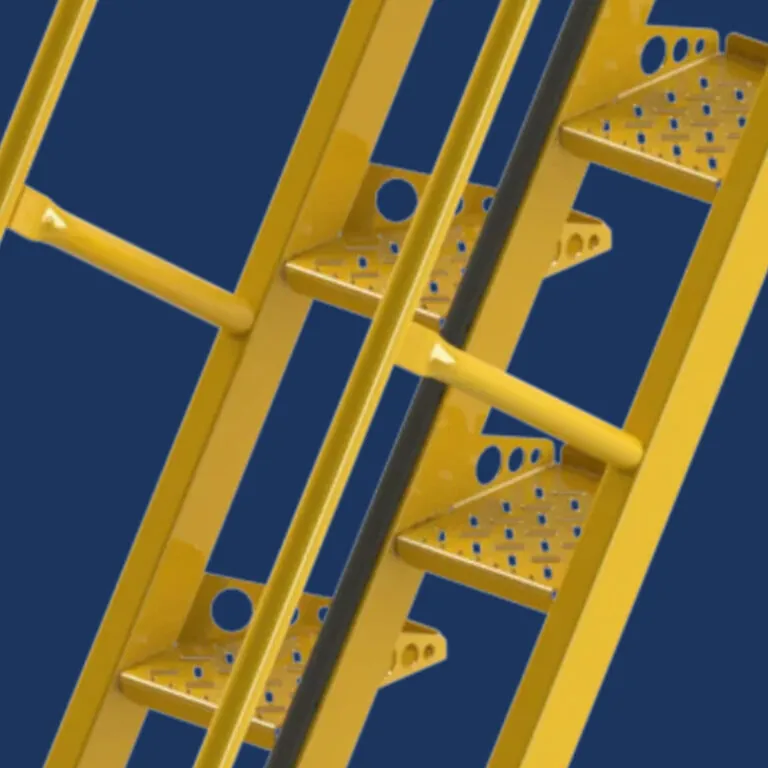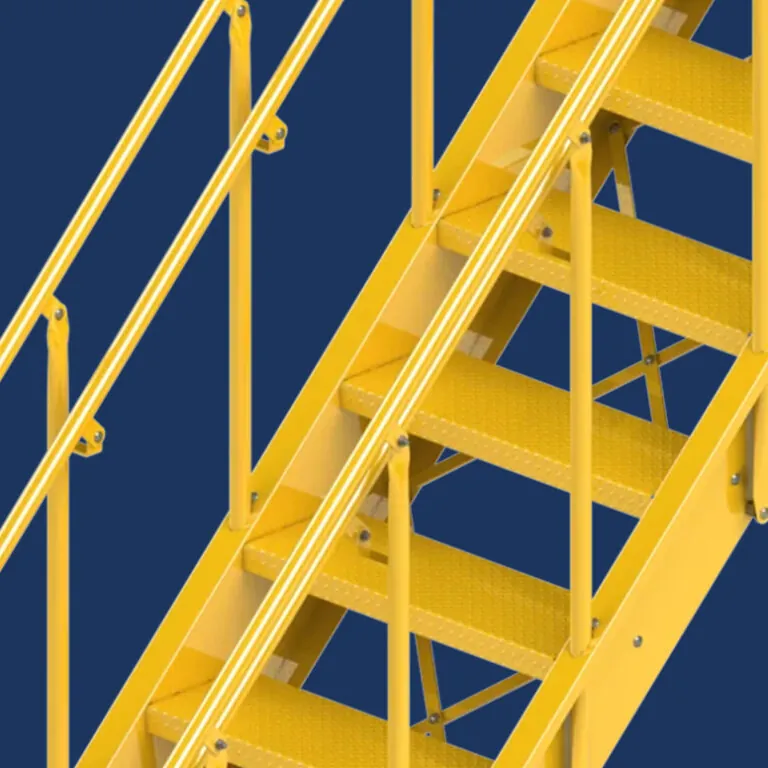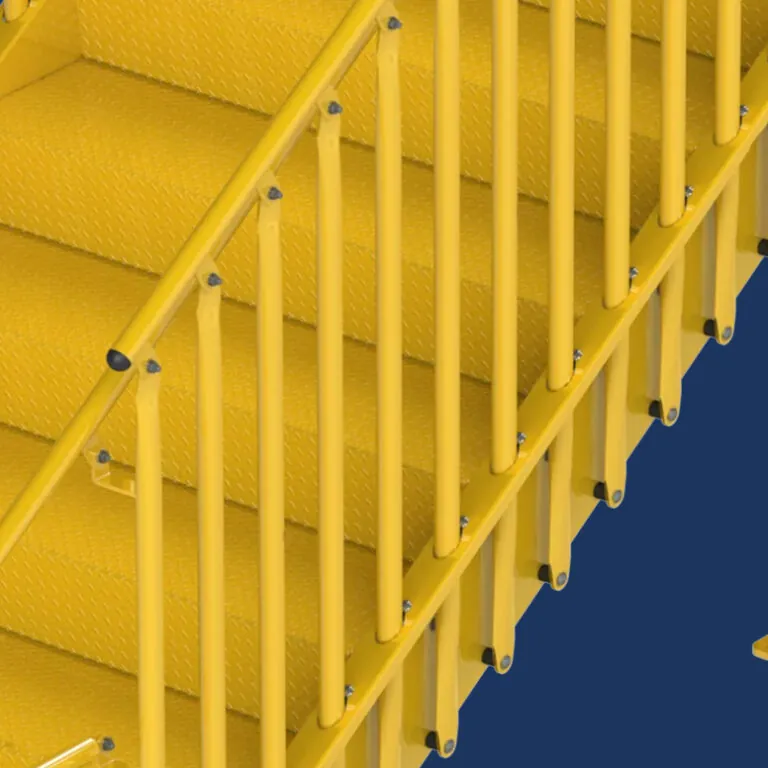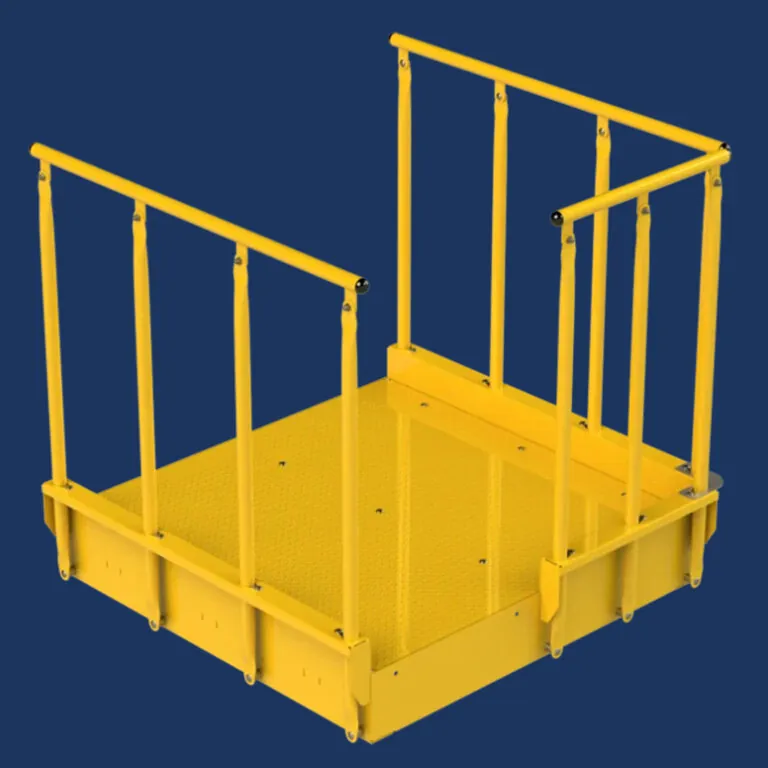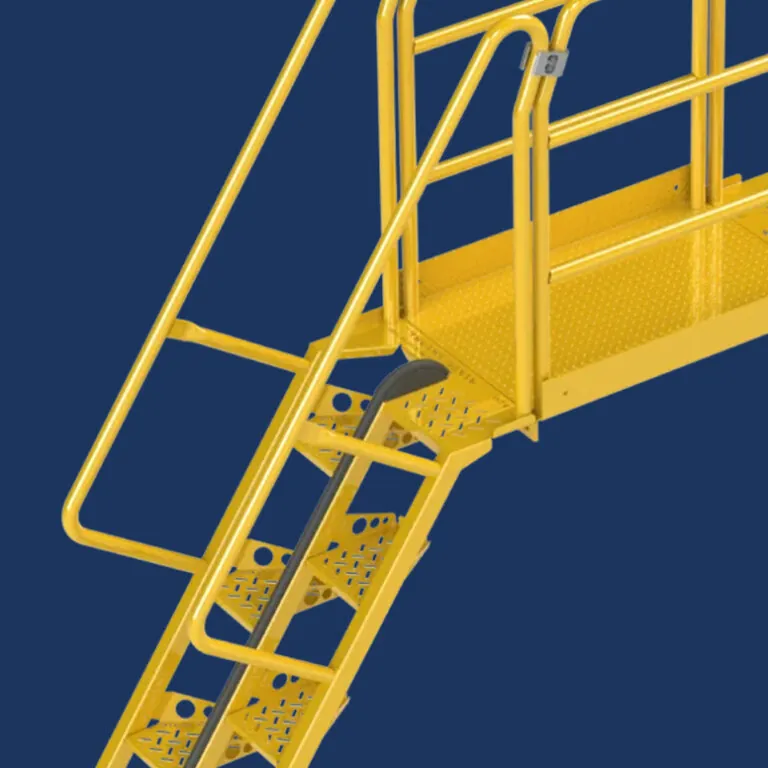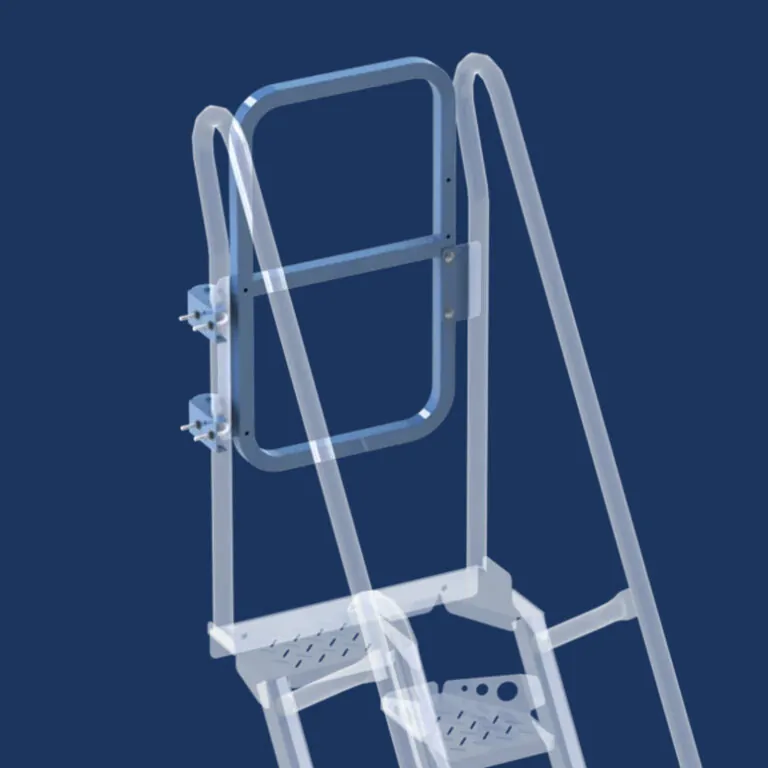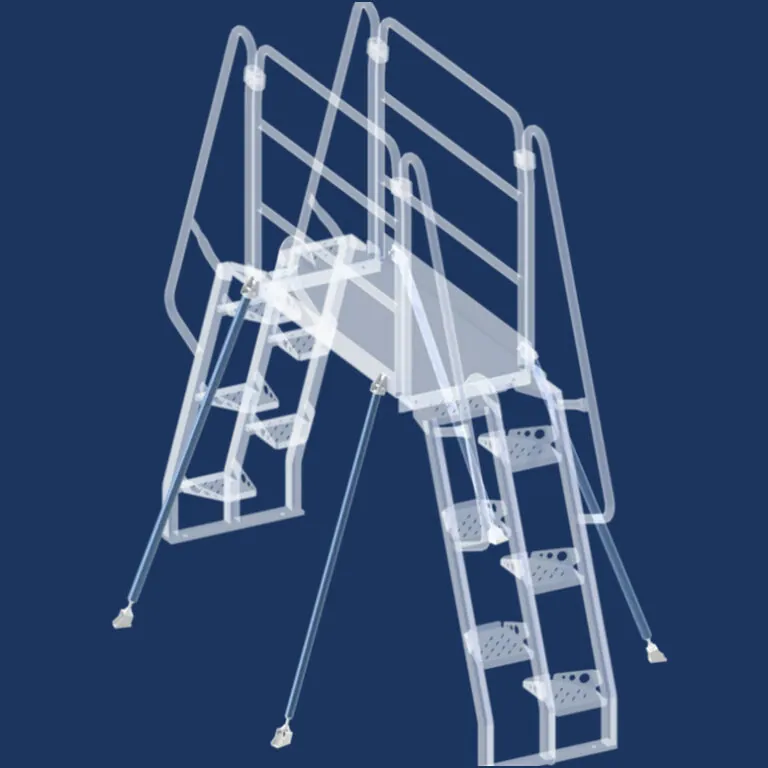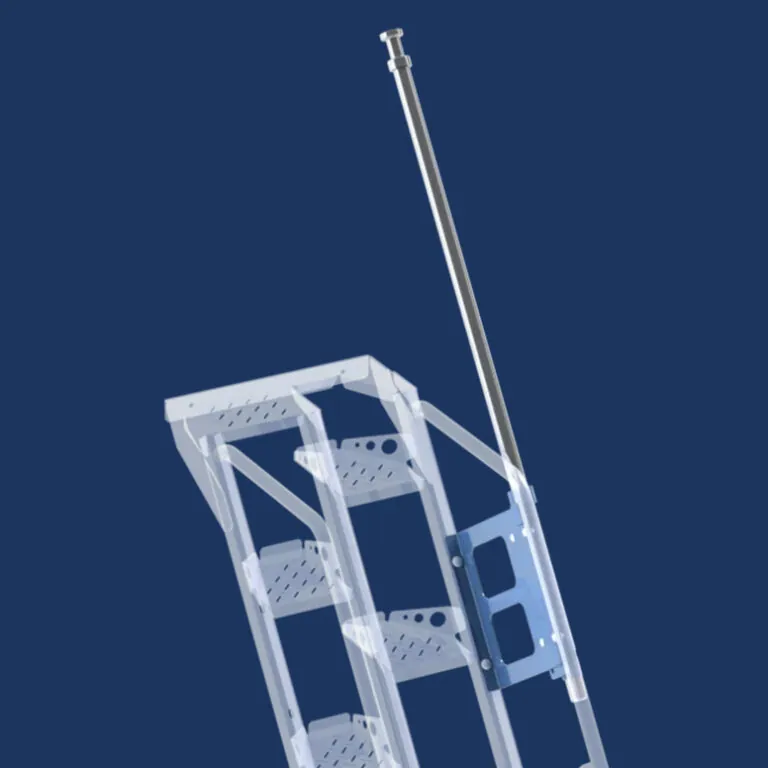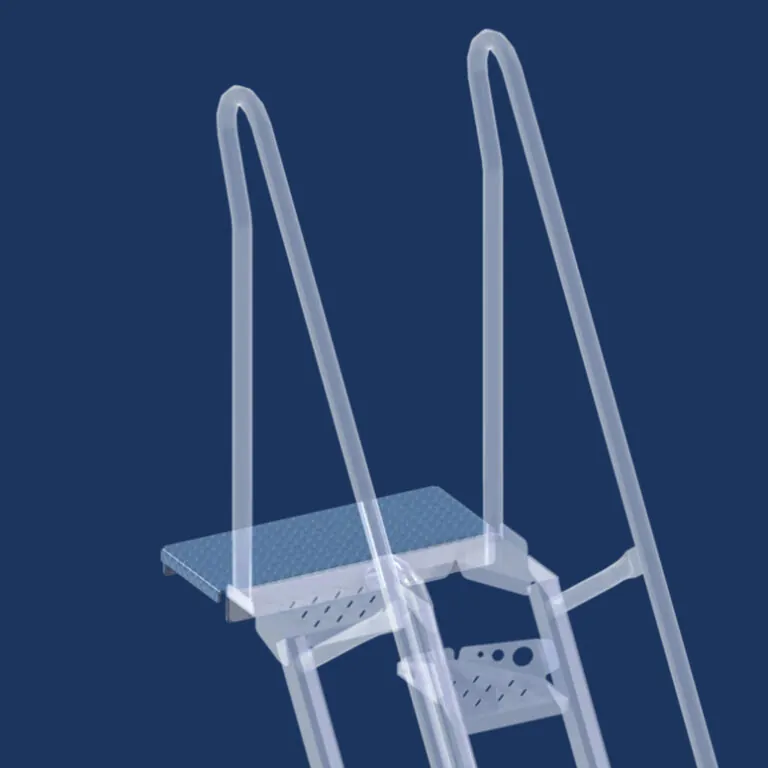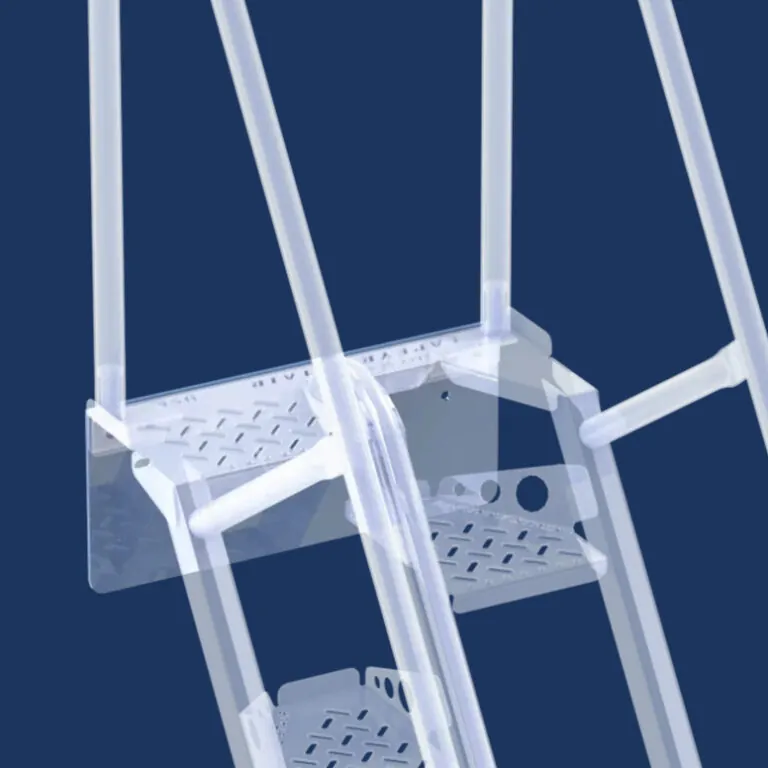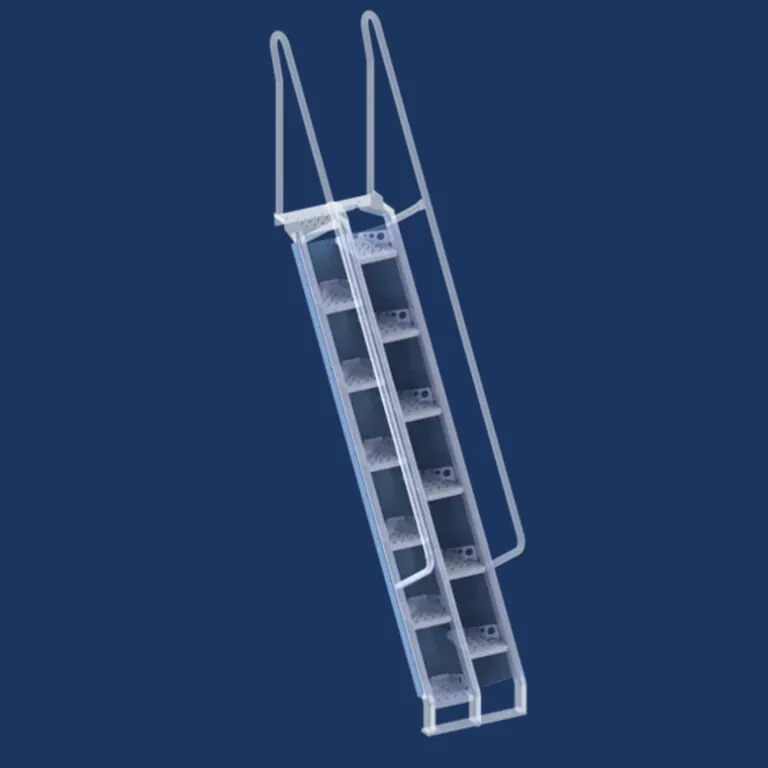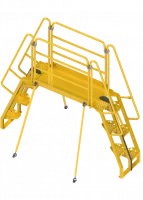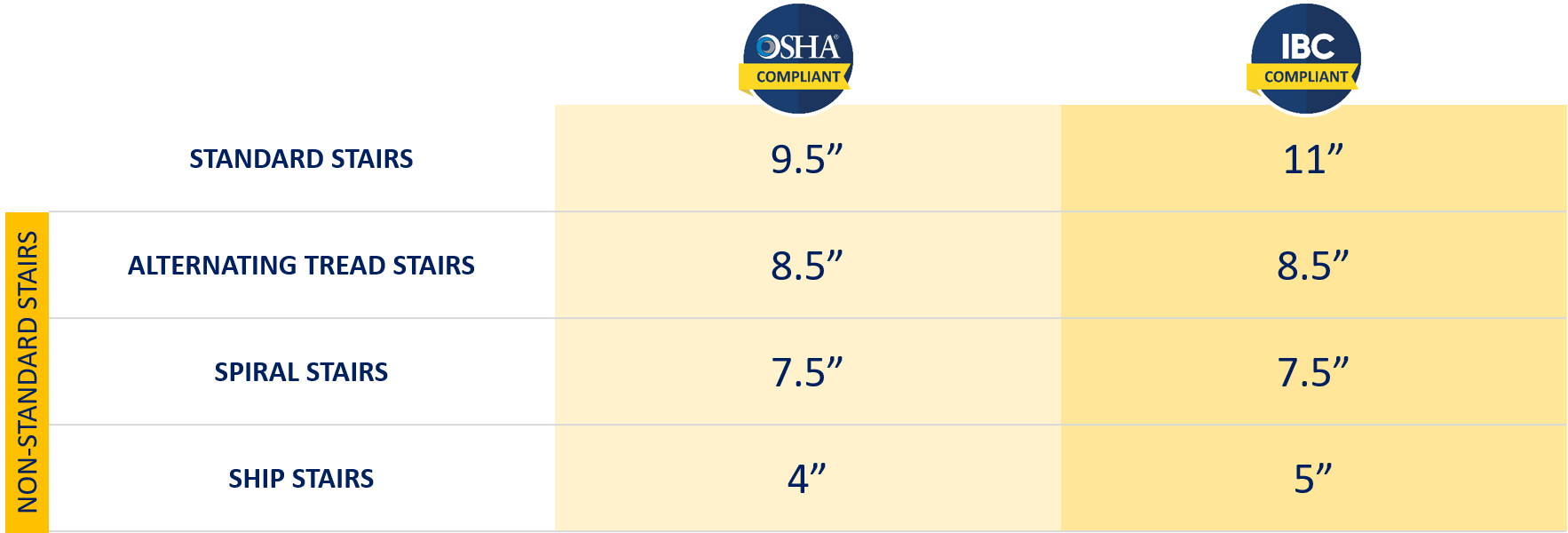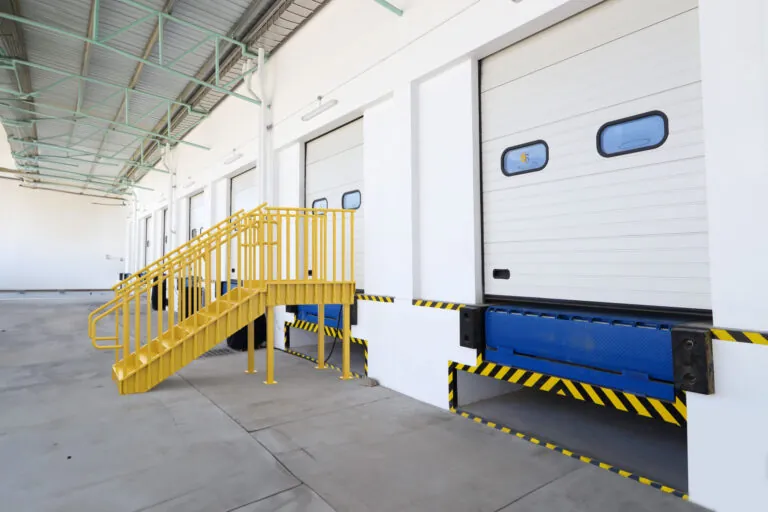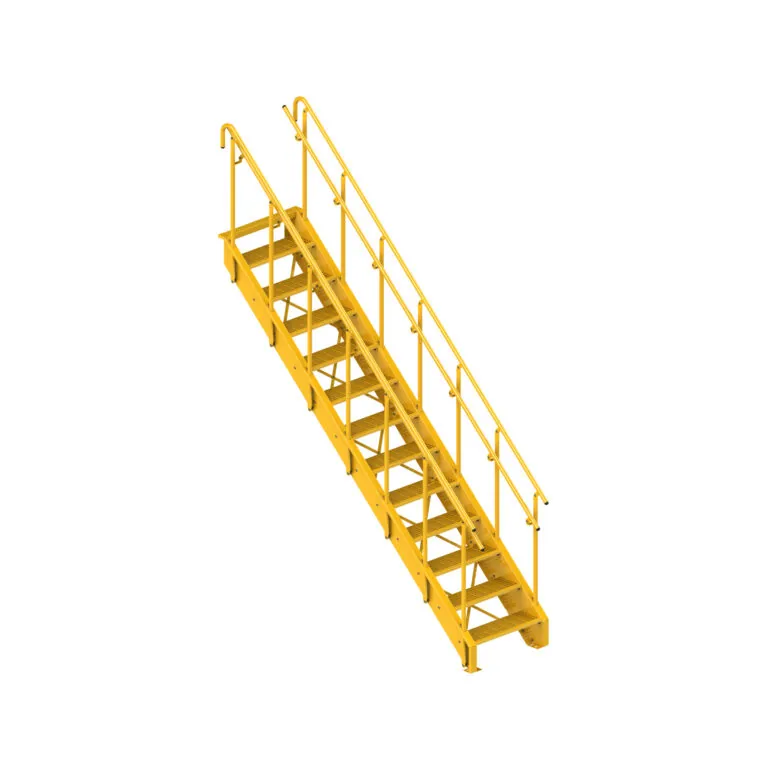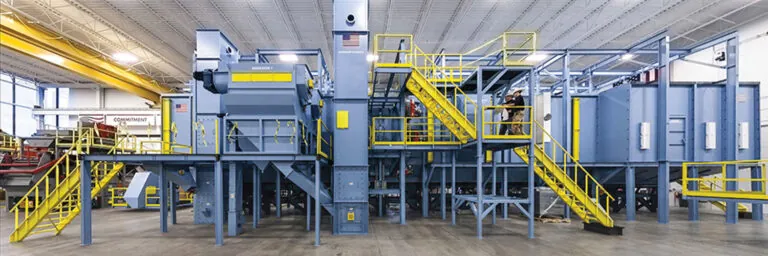Alternating tread stairs, ships ladders, and ship stairs are all steep angled stair devices used in space-restricted applications. How do these devices differ from each other? OSHA and IBC define and set standards for the different designs of steep stairways. This guide will help you understand the different designs and code standards, and help you make the right decision in choosing the safest, code-compliant option.
Table of contents
-
- Types of ship ladders & stairs (& design specifications)
- Alternating tread ships ladder design specifications
- What are alternating tread ships ladders?
- Osha alternating tread ships ladder standards
- IBC alternating tread ships ladder code requirements
- Ships ladder design specifications
- What are ship ladders?
- Osha ships ladder standards
- IBC ships ladder code requirements
- Ship stairs design guidelines
- What are ship stairs?
- Osha ship stairs standards
- IBC ship stairs code requirements
- Ship stairs & ladders: Which is the right choice for you?
- Alternating tread device vs ships ladder
Types of ship ladders & stairs (& design specifications)
The two most common types of steep angled stair devices for space constrained applications are alternating tread stairs and ship stairs or ships ladders.
OSHA Section 1910.21(b) defines ship stairs (ship ladder), and alternating tread-type stairs:
Ship stair (ship ladder) means a stairway that is equipped with treads, stair rails, and open risers, and has a slope that is between 50 and 70 degrees from the horizontal.
Alternating tread-type stair means a type of stairway consisting of a series of treads that usually are attached to a center support in an alternating manner such that an employee typically does not have both feet on the same level while using the stairway.
Alternating tread ships ladder design specifications
Alternating tread stairs use a staggered step design to increase tread depth at steep angles to save space. This design allows for a safer, face-forward descent down the stair.
Standard stair
On a standard stair, each foot normally uses only about half of each tread, stepping out and over the unused section. 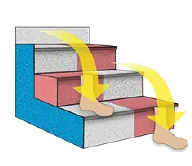
Ship stair
On a ship stair, the unused half tread becomes an obstacle by reducing the usable depth of the tread below. 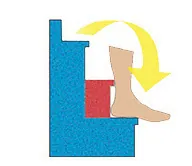
Alternating tread stair
On an alternating tread stair, the unused half tread is removed to provide more tread depth for improved safety and comfort. 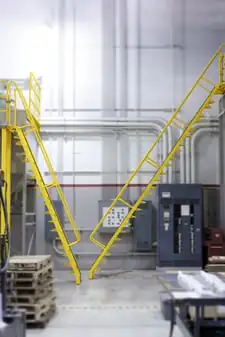
The video demonstrates the difference in walking down an alternating tread stair next to a steep stair. The increased tread depth gives the user a complete surface to rest each step.
What are alternating tread ships ladders?
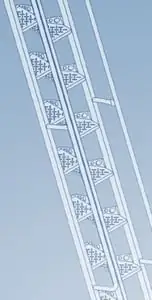 Alternating tread stairs are a type of ships ladder or ship stair device. They are used in applications with space constraints to save floor space. Typical applications for alternating tread stairs include conveyor and equipment access, work platforms, crossover stairs, and anywhere in a facility that does not have space for a standard stair design.
Alternating tread stairs are a type of ships ladder or ship stair device. They are used in applications with space constraints to save floor space. Typical applications for alternating tread stairs include conveyor and equipment access, work platforms, crossover stairs, and anywhere in a facility that does not have space for a standard stair design.OSHA defines Alternating tread-type stair as a type of stairway consisting of a series of treads that usually are attached to a center support in an alternating manner such that an employee typically does not have both feet on the same level while using the stairway.
2018 International Building Code (IBC) defines an Alternating tread device as a device that has a series of steps between 50 and 70 degrees from horizontal, usually attached to a center support rail in an alternating manner so that the user does not have both feet on the same level at the same time.
Osha alternating tread ships ladder standards
OSHA set the design requirements for alternating tread stairs in section 1910.25(f) below:
- 1910.25(f)(1) Have a series of treads installed at a slope of 50 to 70 degrees from the horizontal;
- 1910.25(f)(2) Have a distance between handrails of 17 to 24 inches (51 to 61 cm);
- 1910.25(f)(3) Have a minimum tread depth of 8.5 inches (22 cm); and
- 1910.25(f)(4) Have open risers if the tread depth is less than 9.5 inches (24 cm);
- 1910.25(f)(5) Have a minimum tread width of 7 inches (18 cm), measured at the leading edge of the tread (i.e., nosing).
OSHA 1910.28 also requires that alternating tread stairs and ship stairs have handrails:
- 1928(b)(11)(iii) Each ship stairs and alternating tread type stairs is equipped with handrails on both sides.
The side mounted handrails also act as the guardrail fall protection for the device. Because they have an integrated side-mounted hand / guardrail, alternating tread stairs do not need to be used with fall arrest systems.
OSHA also sets standards for how an alternating tread stair can be used by employers.
- OSHA §1910.25(b)(8) Spiral, ship, or alternating tread-type stairs are used only when the employer can demonstrate that it is not feasible to provide standard stairs.
Usually, alternating tread stairs or ship stairs are used when there are space restrictions that make it not feasible to provide standard stairs.
Because alternating tread stairs have a full usable tread surface for each foot, the stairs are designed to be descended face-forward like a standard stair. They are not subject to the requirements of OSHA 1910.23 Ladders for facing the ladder (backing down the ladder) while climbing. The face-forward descent allows users to see in the direction of travel and more easily carry tools or items while descending.
IBC alternating tread ships ladder code requirements
IBC design requirements for an alternating tread device are found in section 1011.14.2:
Alternating tread devices shall have a minimum tread depth of 5 inches, a minimum projected tread depth of 8 1/2″, a minimum tread width of 7 inches, and a maximum riser height of 9 1/2.” The tread shall be measured horizontally between the vertical planes of the foremost projections of the adjacent treads. The riser height shall be measured vertically between the leading edges of adjacent treads. The riser height and tread depth shall result in an angle of ascent from the horizontal of between 50 and 70 degrees.
IBC also has strict requirements for how alternating tread stairs can be used as a means of egress.
IBC Section 1011.14 states that Alternating tread devices are limited to an element of a means of egress in buildings of Groups F, H, and S from a mezzanine not more then 250 square feet in area and that serves not more than five occupants; in buildings of Group I-3 from a guard tower, observation station or control room not more than 250 square feet in area and for access to unoccupied roofs.
IBC also allows an exception to IBC 1011.12 so that access to the roof from the top story is permitted to be by an alternating tread device, a ships ladder, or a permanent ladder. Also, the exception to IBC 1011.12.2 allows access to unoccupied roofs to be a roof hatch or trap door.
So for unoccupied roofs, a ladder or alternating tread stair extending through a roof hatch is the most common method of accessing the roof.
Ships ladder design specifications
Ships ladders are steep angled stair devices with angles between 50 and 70 degrees. This is much steeper than the typical angle of stairs of 45 degrees per OSHA and 30-32 degrees per IBC. Because they are so steep, ships ladders have much less usable tread depth than a standard OSHA or IBC stair design.
What are ship ladders?
Ship stairs and ship ladders are addressed by both OSHA and IBC. OSHA uses the terms ship stair and ship ladder interchangeably while IBC uses the term ships ladder. OSHA requires that all ladders between 60 and 90 degrees be device-facing, so any ships ladder that is angled 60 degrees or steeper must be descended backing down.
OSHA defines a ship stair in section 1910.21(b) as:
“A stair that is equipped with treads, stair rails, and open risers, and has a slope that is between 50 and 70 degrees from the horizontal.”
In essence, a ship stair is just a very steep stair. This image below from OSHA 1910.25 – Stairways shows two ship stairs at different angles.
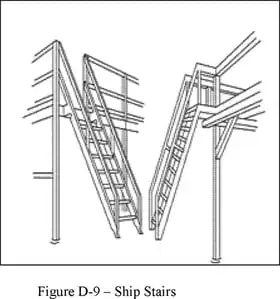
White Paper Download: Safety of alternating tread stairs vs ship stairs 
Osha ships ladder standards
OSHA provides the ship ladder standards in section 1910.25(e) below:
- 1910.25(e) Ship stairs. In addition to paragraph (b) of this section, the employer must ensure ship stairs (see Figure D-9 of this section):
- 1910.25(e)(1) Are installed at a slope of 50 to 70 degrees from the horizontal;
- 1910.25(e)(2) Have open risers with a vertical rise between tread surfaces of 6.5 to 12 inches (17 to 30 cm);
- 1910.25(e)(3) Have minimum tread depth of 4 inches (10 cm); and
- 1910.25(e)(4) Have a minimum tread width of 18 inches (46 cm).
OSHA also defines angles for each type of stairway and ladder. Here is a chart comparing the angles of all the different types of stairs.
Angle
Type
≤ 30° Ramp 30° – 50° Standard Stairs 50° – 70° Ship Stairs 50° -70° Alternating Tread-Type Stairs 60° – 90° Ladders Like the alternating tread stair, OSHA 1910.28 also requires that ship stairs have handrails:
- 1928(b)(11)(iii) Each ship stairs and alternating tread type stairs is equipped with handrails on both sides.
The side mounted handrails also act as the guardrail fall protection for the device. Because they have an integrated side-mounted hand / guardrail, ships ladders do not need to be used with fall arrest systems.
OSHA also sets standards for how ships ladders can be used by employers.
- OSHA §1910.25(b)(8) Spiral, ship, or alternating tread-type stairs are used only when the employer can demonstrate that it is not feasible to provide standard stairs.
Since ships ladders have very narrow tread surface, they must typically be descended backwards like a vertical ladder. When backing down a ladder, OSHA requires that users use at least one hand for grasping and do not carry tools or items that can cause loss of balance.
- 1910.23(b)(12) Each employee uses at least one hand to grasp the ladder when climbing up and down it; and
- 1910.23(b)(13) No employee carries any object or load that could cause the employee to lose balance and fall while climbing up or down the ladder.
IBC ships ladder code requirements
IBC addresses ships ladder design in section 1011.15:
1011.15.1 Handrails of ships ladders
Handrails shall be provided on both sides of ships ladders. And per 1011.15, the minimum clear width at and below the handrails shall be 20 inches.
1011.15.2 Treads of ships ladders
Ships ladders shall have a minimum tread depth of 5 inches (127mm). The tread shall be projected such that the total of the tread depth plus the nosing projection is not less than 8 1/2 inches (216mm). The maximum riser height shall be 9 ½ inches (241 mm).
IBC also sets strict standards for how ships ladders can be used as a means of egress.
IBC section 1011.15 Ship Ladders states that ships ladders are permitted to be used in Group I-3 as a component of a means of egress to and from control rooms or elevated facility observation station not more than 250 square feet with not more than three occupants and for access to unoccupied roofs.
Ship stairs design guidelines
Ship stairs and ship ladders (or ships ladder) are terms often used to mean the same type of device. OSHA uses the term ship stair while IBC uses the term ships ladder. The design requirements are the same for ship stairs as they are for ships ladders no matter the terminology.
What are ship stairs?
What is the difference between a ship stair and a ship ladder?
A key difference between a stair and a ladder is the way in which they are used. OSHA 1910.23 states the following requirements on employees using ladders.
1910.23(b)(11) Each employee faces the ladder when climbing up or down it;
1910.23(b)(12) Each employee uses at least one hand to grasp the ladder when climbing up and down it; and
1910.23(b)(13) No employee carries any object or load that could cause the employee to lose balance and fall while climbing up or down the ladder.
Stairways, ship stairs, and alternating tread stairs are not subject to these requirements. Stairways and alternating tread stairs can both be descended face forward in the direction of travel. Some ship stairs can be descended face forward depending on how steep the angle. The angles of ship stairs and ladders overlap between 60 and 70 degrees. Ship stairs can be as steep as 70 degrees, while ladders can be as shallow as 60 degrees.
Ship stairs shallower than 60 degrees can be designed as face-forward descent devices. However, because these devices have much shorter tread depth, walking down face-forward is very difficult and potentially unsafe for the user. Users are left with a very small tread surface for each foot causing a fall hazard. You can see that in this photo below.
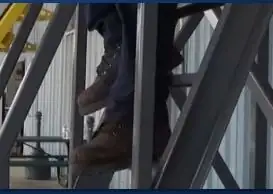
In many cases, backing down ship stairs is a safer alternative even though the user cannot see where they are going while backing down.
In the case of backing down ships ladders, employees should follow the same OSHA rules for descending ship ladders as for descending fixed ladders. Employees should use at least one hand to grasp the ladder while backing down and should not carry objects while climbing the ladder.
How ship stairs or ship ladders are designed to be descended is up to the designer or operator. Designers should consider that as stairs get steeper, tread depth shortens and becomes a major risk factor of stairway design. For standard ship stairs, a shallower angle is safer than a steep angle. Alternating tread stairs have the unused half of each tread removed to provide more tread depth at steeper angles. These are all considerations that should be factored into your next design.
For more info, download our guide on stair design for safety and ergonomics.
Osha ship stairs standards
Because OSHA uses the term ship stairs and ship ladder interchangeably, the OSHA standards for ship stairs are the same as for ship ladders.
IBC ship stairs code requirements
IBC uses the term ships ladder rather than the term ship stairs. IBC does not refer anywhere in the code to the term ship stair. The IBC code requirements for ship stairs is the same as for ships ladders.
Ship stairs & ladders: Which is the right choice for you?
When choosing between a standard stair, ship stair, or alternating tread stair, the most important consideration is safety. Which stair design is the safest?
It helps to understand the a few of the most important design induced safety factors of stairway design as outlined in Chapter 13 of Fall Protection and Prevention: Principles, Guidelines, and Practices.
- As tread depth becomes narrower than a foot length, missteps become more frequent. Shorter treads give insufficient foot support and cause postural instabilities
- There may be no graspable, reachable handrail
- There may be a discontinuous handrail
- There may be confusing color patterns on the tread or poor visibility of nosings
- The nosing strip may project above the tread
Of these safety factors, adequate stair tread depth is the most variable between the different stair design.
Here is a table showing the minimum tread depth requirements for the different stair types.
From this chart, you can see that standard stairs have the most tread depth, followed by alternating tread stairs, followed by spiral stairs, then ship stairs.
Alternating tread device vs ships ladder
How do we know that tread depth is an important safety factor and that alternating tread stairs are safer than ship stairs?
Many studies have demonstrated that narrow tread depth is a risk factor for stairways. A recent study measured the perceived difficulty in descent of stairways. This study, by Hisao Nagato, of the Ohara Memorial Institute for Science of Labor in Japan, looked at how difficult it was for users to descend stairways with varying tread depths. The result showed that stairs become increasingly difficult to descend as tread depth narrows. To measure the difficulty, the researchers used a metric called the Z-value, which increases as difficulty increases. Below is a chart showing the Z-values for different stair designs. Ship stairs were shown to have very high perceived difficulty while descending due to the short tread depth.
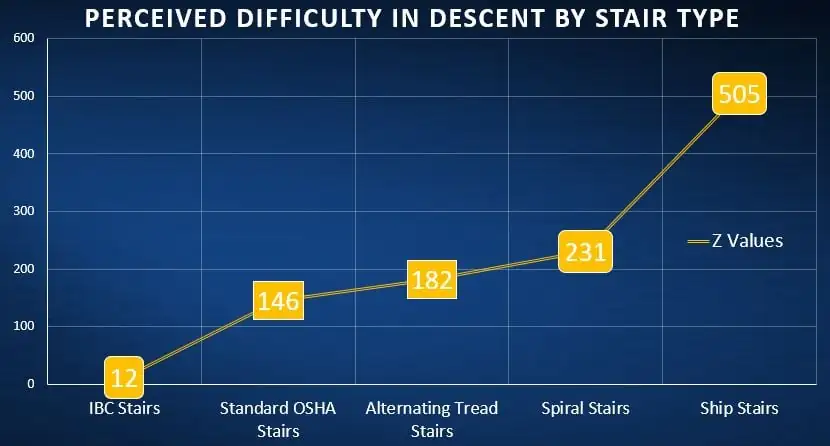
Another study by Virginia Tech Human Factors Engineering Laboratory demonstrated that alternating tread stairs had 72% fewer missteps than ship stairs and were preferred by users. The participants in that study also rated the alternating tread stairs higher for both safety and comfort during descent.
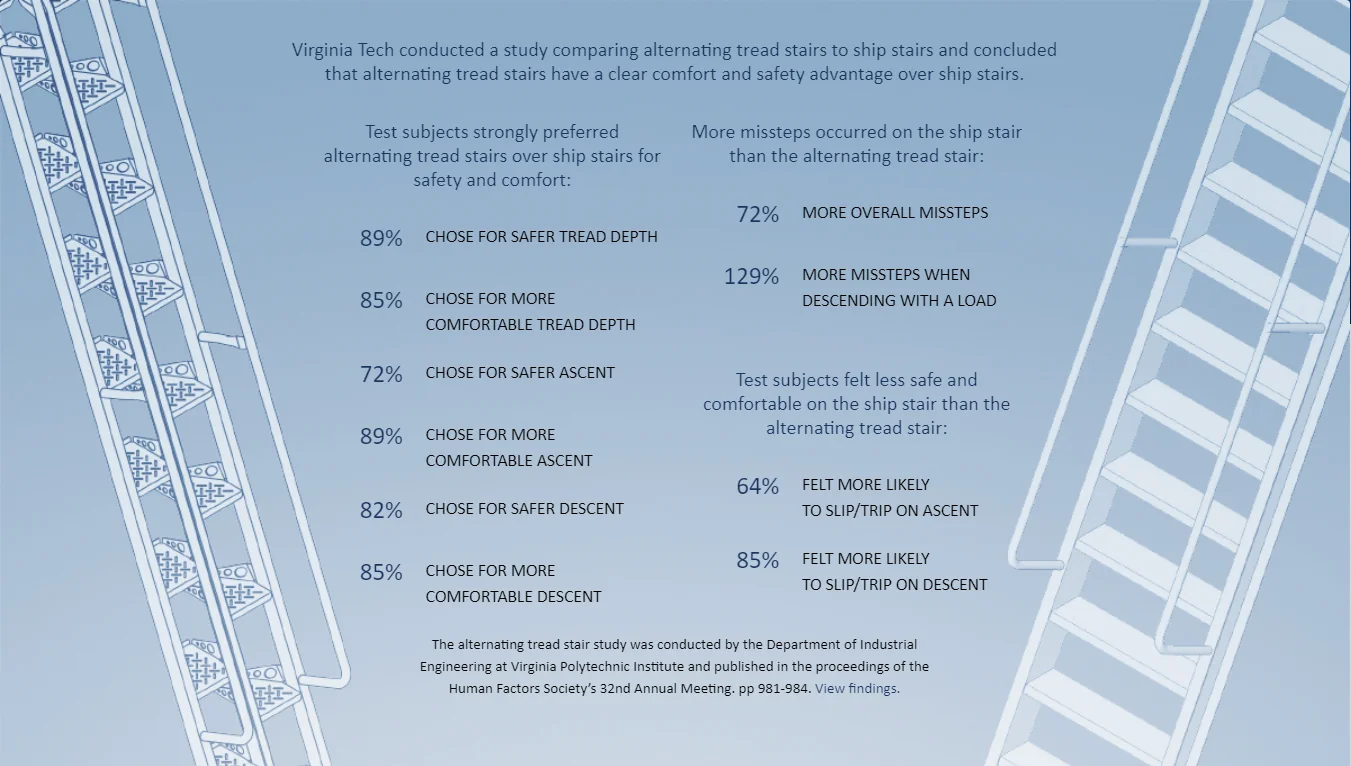
Conclusion
The results are clear. The alternating tread stair is the safer, more comfortable option when it comes to space saving stairs. If you have limited space and need a steep stair, choose the alternating tread stair.
FAQ
What angle is a ship ladder?
A ship ladder angle is between 50 and 70 degrees. OSHA section 1910.25(e)(1) requires ship ladders to be installed at a slope of 50 to 70 degrees from the horizontal.
What is an alternating tread staircase?
An alternating tread staircase is a type of steep, safety stair with a staggered step design. Alternating tread stairs have steep angles to save space. The staggered step design increases the usable tread depth to provide the user a full tread surface on each step.
Are alternating tread stairs legal?
Alternating tread stairs are legal to install and use in space-restricted areas under OSHA section 1910.25. Alternating tread-type stairs are used only when the employer can demonstrate that it is not feasible to provide standard stairs.

